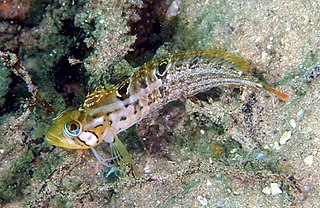The Bot River klipfish is a species of clinid endemic to South Africa where it is found in brackish waters of the Bot River and the Kleinmond Estuary where it lives amongst weeds. This species can reach a length of 17.5 centimetres (6.9 in) TL.
Chalaroderma is a genus of combtooth blennies found in the southeast Atlantic ocean.

Omobranchus is a large genus of combtooth blennies found in the Pacific, Atlantic, and Indian oceans.
Blennioclinus is a genus of clinids found in the southeastern Atlantic and western Indian Ocean.
Blennophis is a genus of clinids found in the southeastern Atlantic ocean.
Clinoporus biporosus, the ladder klipfish, is a species of clinid found in subtropical waters of the Atlantic Ocean around the South African coast. It occurs in the subtidal zone down to a depth of 30 metres (98 ft). This species can reach a maximum length of 13 centimetres (5.1 in) TL. It is currently the only known member of the genus Clinoporus.

Pavoclinus is a genus of clinids found in the southeastern Atlantic and western Indian Ocean coastal waters of southern Africa.

Clinus acuminatus, the sad klipfish, is a species of fish in the family Clinidae. It is endemic to Southern Africa, where it occurs along the coast of Namibia and South Africa. It can reach a maximum length of 13 centimetres (5.1 in) TL and is viviparous. The sad klipfish feeds on crustaceans.

Clinus berrisfordi, the Onrust klipfish, is a species of clinid that occurs in subtropical waters of the Atlantic Ocean from False Bay to Skoenmakerskop, South Africa where it prefers marine and brackish habitats with plentiful growth of seaweed. This species can reach a maximum length of 12 centimetres (4.7 in) TL.
Clinus brevicristatus, the Cape klipfish, is a species of clinid that occurs in subtropical waters of the Atlantic Ocean around South Africa where it prefers habitats with plentiful growth of seaweed. This species can reach a maximum length of 12 centimetres (4.7 in) TL.
Clinus helenae, the Helen's klipfish, is a species of clinid that occurs in subtropical waters of the Atlantic Ocean around South Africa where it is a denizen of tide pools. This species can reach a maximum length of 10 centimetres (3.9 in) TL. The identity of the person honoured in the matronym in this species' specific name is thought to be J.L.B. Smith's mother-in-law Helen Evelyn Zondagh (1877-1951).
Clinus latipennis, the False Bay klipfish, is a species of clinid fish that occurs in subtropical waters of the Atlantic Ocean from Table Bay to Cape Agulhas, South Africa. This species can reach a length of 12 centimetres (4.7 in) TL.

Clinus superciliosus, the Super klipfish or Highfin klipfish, is a species of clinid that occurs in subtropical waters of the Atlantic Ocean from northern Namibia to the Kei River in South Africa where it can be found in the subtidal and intertidal zones. This species can reach a maximum length of 30 centimetres (12 in) TL. This species feeds on benthic crustaceans including amphipods, isopods and crabs; sea urchins; gastropods; polychaete worms and other fishes.

Clinus venustris, the speckled klipfish, is a species of clinid that occurs in subtropical waters of the Atlantic Ocean from Namibia to South Africa where it is found in the subtidal zone as well as being a denizen of tide pools. This species can reach a maximum length of 12 centimetres (4.7 in) TL. and feeds primarily on amphipods, isopods, mysids, and echinoderms.
Clinus woodi, the Oldman klipfish, is a species of clinid that occurs in subtropical waters of the Indian Ocean from Mozambique to South Africa where it can be found in tide pools with plentiful seaweed and in the subtidal zone. This species can reach a maximum length of 16 centimetres (6.3 in) TL. The identity of the person honored in the specific name of the species was not given by J.L.B. Smith but it is thought to be his friend Alexander Thomas Wood (1872-1957) of Xora Mouth, South Africa which is the type locality for C. woodi. Wood provided specimens to Smith and had a cottage that Smith often used as a base for carrying out fieldwork.

Lethrinus is a genus of marine ray-finned fishes belonging to the family Lethrinidae, the emperors and emperor breams. These fishes are mostly found in the Indian and western Pacific Oceans, with a single species in the eastern Atlantic Ocean.

The Tstsikamma Marine Protected Area is a marine protected area on the south coast of South Africa, in both the Western Cape and Eastern Cape. It is on the coast of the Tsitsikamma National Park, and is one of the oldest MPAs in the country. The MPA provides protection for marine habitat and wildlife, including birds and threatened and endangered fish species.

Clinus exasperatus is a species of clinid which is known from only two specimens collected in the sea from among kelp, in Betty's Bay in South Africa. The specific name refers to Sophie van der Heyden's exasperation at her failure to find a second specimen.

Clinus musaicus, the mosaic klipfish, is a species of bony fish from the family Clinidae, the kelp blennies. It is endemic to the waters off the Western Cape in South Africa where it occurs off the Cape Peninsula in False Bay on the Peninsula's eastern coast and the Atlantic Ocean off its western coast. All the specimens were collected from areas of flat, sandy substrates with scattered shell fragments.










